Related Research Articles

Amblygonite is a fluorophosphate mineral, (Li,Na)AlPO4(F,OH), composed of lithium, sodium, aluminium, phosphate, fluoride and hydroxide. The mineral occurs in pegmatite deposits and is easily mistaken for albite and other feldspars. Its density, cleavage and flame test for lithium are diagnostic. Amblygonite forms a series with montebrasite, the low fluorine endmember. Geologic occurrence is in granite pegmatites, high-temperature tin veins, and greisens. Amblygonite occurs with spodumene, apatite, lepidolite, tourmaline, and other lithium-bearing minerals in pegmatite veins. It contains about 10% lithium, and has been utilized as a source of lithium. The chief commercial sources have historically been the deposits of California and France.
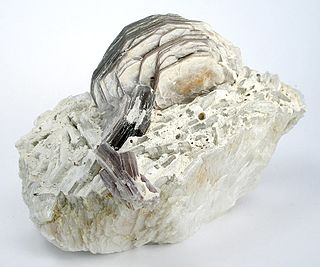
Lepidolite is a lilac-gray or rose-colored member of the mica group of minerals with chemical formula K(Li,Al)3(Al,Si,Rb)4O10(F,OH)2. It is the most abundant lithium-bearing mineral and is a secondary source of this metal. It is the major source of the alkali metal rubidium.

The mineral group tantalite [(Fe, Mn)Ta2O6] is the primary source of the chemical element tantalum, a corrosion (heat and acid) resistant metal. It is chemically similar to columbite, and the two are often grouped together as a semi-singular mineral called coltan or "columbite-tantalite" in many mineral guides. However, tantalite has a much greater specific gravity than columbite (8.0+ compared to columbite's 5.2). Iron-rich tantalite is the mineral tantalite-(Fe) or ferrotantalite and manganese-rich is tantalite-(Mn) or manganotantalite.
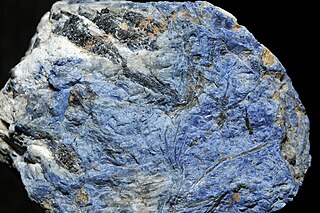
Dumortierite is a fibrous variably colored aluminium boro-silicate mineral, Al7BO3(SiO4)3O3. Dumortierite crystallizes in the orthorhombic system typically forming fibrous aggregates of slender prismatic crystals. The crystals are vitreous and vary in color from brown, blue, and green to more rare violet and pink. Substitution of iron and other tri-valent elements for aluminium result in the color variations. It has a Mohs hardness of 7 and a specific gravity of 3.3 to 3.4. Crystals show pleochroism from red to blue to violet. Dumortierite quartz is blue colored quartz containing abundant dumortierite inclusions.
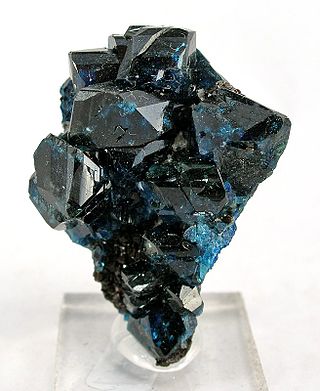
Lazulite ((Mg,Fe2+)Al2(PO4)2(OH)2) is a blue, phosphate mineral containing magnesium, iron, and aluminium phosphate. Lazulite forms one endmember of a solid solution series with the darker iron rich scorzalite.

Zanazziite is a complex hydrated phosphate mineral from the roscherite group. It is a magnesium beryllium phosphate mineral. Zanazziite arises as barrel-shaped crystals and can reach up to 4 mm. It grows alongside quartz minerals. It is found in the crevices of Lavra da Ilha pegmatite, near Taquaral, in northeastern Minas Gerais, Brazil. Zanazziite is named after Pier F. Zanazzi. Zanazziite has an ideal chemical formula of Ca2Mg5Be4(PO4)6(OH)4·6H2O.
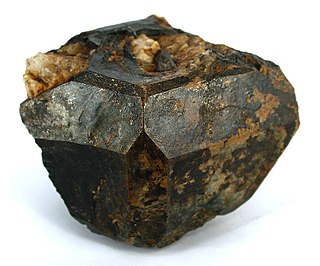
Microlite was once known as a pale-yellow, reddish-brown, or black isometric mineral composed of sodium calcium tantalum oxide with a small amount of fluorine. Its chemical formula is(Na,Ca)2Ta2O6(O,OH,F). Today it is a name of a group of oxide minerals of a similar stoichiometry having tantalum prevailing over titanium and niobium. The microlite group belongs to a large pyrochlore supergroup that occurs in pegmatites and constitutes an ore of tantalum. It has a Mohs hardness of 5.5 and a variable specific gravity of 4.2 to 6.4. It occurs as disseminated microscopic subtranslucent to opaque octahedral crystals with a refractive index of 2.0 to 2.2. Microlite is also called djalmaite, but both names are now obsolete.

Eosphorite is a brown (occasionally pink) manganese hydrous phosphate mineral with chemical formula: MnAl(PO4)(OH)2·H2O. It is used as a gemstone.

Betafite is a mineral group in the pyrochlore supergroup, with the chemical formula (Ca,U)2(Ti,Nb,Ta)2O6(OH). Betafite typically occurs as a primary mineral in granite pegmatites, rarely in carbonatites. Originally defined by the B-site atom Ti, the development of new nomenclature for mineral names led to modernization of the system for nomenclature of pyrochlore and betafite in order to further rationalize the naming process of this grouping of minerals. Only two of the mineral species that were formerly recognized as betafite are presently retained. They are oxyuranobetafite and oxycalciobetafite. The term betafite is now a synonym or varietal group name under the pyrochlore super group.

Tapiolite [(Fe, Mn)(Nb, Ta)2O6] is a black mineral series that is an ore of niobium and tantalum. The tapiolite group includes tapiolite-(Fe) or ferrotapiolite and tapiolite-(Mn) or manganotapiolite. Tapiolite-(Fe) is by far the more common of the two.

Cyrilovite (NaFe33+(PO4)2(OH)4·2(H2O)) is a hydrous sodium iron phosphate mineral. It is isomorphous and isostructural with wardite, the sodium aluminium counterpart.
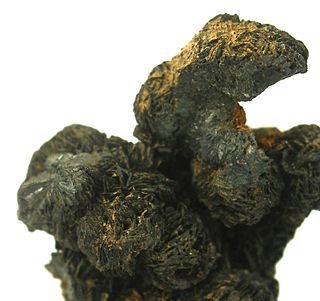
Hagendorfite is an iron phosphate mineral with the chemical formula of (Na,Ca)MnFe2(PO4)3 and is named after where the mineral was discovered, Hagendorf-Süd, Bavaria, Germany.

Ludlamite is a rare phosphate mineral with chemical formula (Fe,Mn,Mg)3(PO4)2·4H2O. It was first described in 1877 for an occurrence in Wheal Jane mine in Cornwall, England and named for English mineralogist Henry Ludlam (1824–1880).

Stibarsen or allemontite is a natural form of arsenic antimonide (AsSb) or antimony arsenide (SbAs). The name stibarsen is derived from Latin stibium (antimony) and arsenic, whereas allemonite refers to the locality Allemont in France where the mineral was discovered. It is found in veins at Allemont, Isère, France; Valtellina, Italy; and the Comstock Lode, Nevada; and in a lithium pegmatites at Varuträsk, Sweden. Stibarsen is often mixed with pure arsenic or antimony, and the original description in 1941 proposed to use stibarsen for AsSb and allemontite for the mixtures. Since 1982, the International Mineralogical Association considers stibarsen as the correct mineral name.

Ixiolite is an accessory oxide mineral found in granitic pegmatites. It is an oxide with the general chemical formula (Ta,Nb,Sn,Mn,Fe)4O8 or (Ta,Mn,Nb)O2.

Schiavinatoite is a very rare mineral, a natural niobium borate with the chemical formula (Nb,Ta)BO4. Schiavinatoite is classified as monoborate. It contains tetrahedral borate anion instead of planar BO3 group, which is more common among minerals. Schiavinatoite is one of the most simple niobium minerals. It forms a solid solution with its tantalum-analogue, béhierite. Both minerals possess zircon-type structure (tetragonal, space group I41/amd) and occur in pegmatites. Schiavinatoite and nioboholtite are minerals with essential niobium and boron.
Nioboholtite is an extremely rare mineral with the formula (Nb0.6[]0.4)Al6BSi3O18. It is the niobium-rich member of the dumortierite supergroup, and the niobium analogue of holtite of the holtite group. It is one of three quite recently found minerals of this group, the other two being titanoholtite and szklaryite, all coming from the Szklary village near Ząbkowice Śląskie in Poland. They occur in a unique pegmatite. Nioboholtite and schiavinatoite are both minerals with essential niobium and boron.
Titanoholtite is an extremely rare mineral with the formula (Ti0.75[]0.25)Al6BSi3O18. It is titanium-rich member of dumortierite supergroup, and titanium-analogue of holtite of the holtite group. It is one of three quite recently found minerals of this group, the other two being nioboholtite and szklaryite, all coming from the Szklary village near Ząbkowice Śląskie in Poland. They occur in a unique pegmatite of probable anatectic origin.

Seidozerite is a sorosilicate from the seidozerite supergroup (a "titanium disilicate"). It was first described by Semenov, Kazakova and Simonov in 1958. Its chemical formula is Na4MnZr2Ti(Si2O7)2O2F2 and its type locality is 'Pegmatite No. 58', Lake Seydozero, Lovozero massif, Kola peninsula, Murmansk Oblast.

Strunzite (Mn2+Fe3+2(PO4)2(OH)2{{·}}6H2O) is a light yellow mineral of the strunzite group, first discovered in 1957.
References
- ↑ Warr, L.N. (2021). "IMA–CNMNC approved mineral symbols". Mineralogical Magazine. 85 (3): 291–320. Bibcode:2021MinM...85..291W. doi: 10.1180/mgm.2021.43 . S2CID 235729616.
- 1 2 3 4 Pieczka, A.; Evans, R. J.; Grew, E. S.; Groat, L. A.; Ma, C.; Rossman, G. R. (2013). "The dumortierite supergroup. II. Three new minerals from the Szklary pegmatite, SW Poland: Nioboholtite, (Nb0.6〈0.4)Al6BSi3O18, titanoholtite, (Ti0.75〈0.25)Al6BSi3O18, and szklaryite, 〈Al6BAs3+3O15" (PDF). Mineralogical Magazine. 77 (6): 2841. Bibcode:2013MinM...77.2841P. doi:10.1180/minmag.2013.077.6.10. S2CID 51740732.
- 1 2 "Szklaryite: Szklaryite mineral information and data". Mindat.org. Retrieved 2016-03-03.
- ↑ Pieczka, A., 2000. A rare mineral-bearing pegmatite from the Szklary serpentinite massif, the Fore-Sudetic Block, SW Poland. Geologia Sudetica 33, 23-31